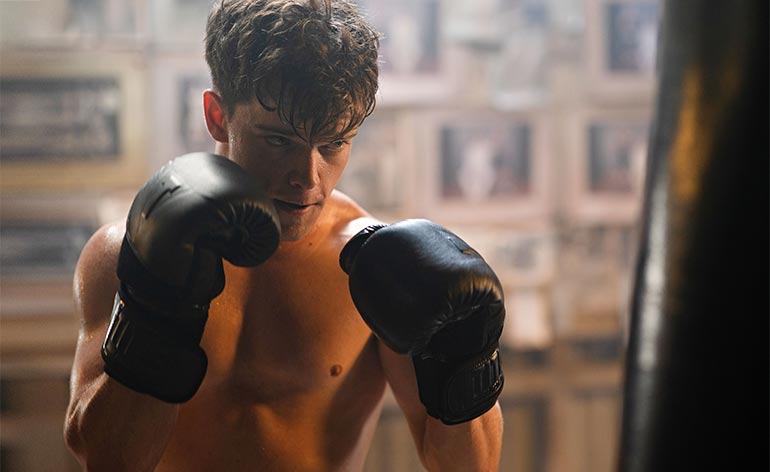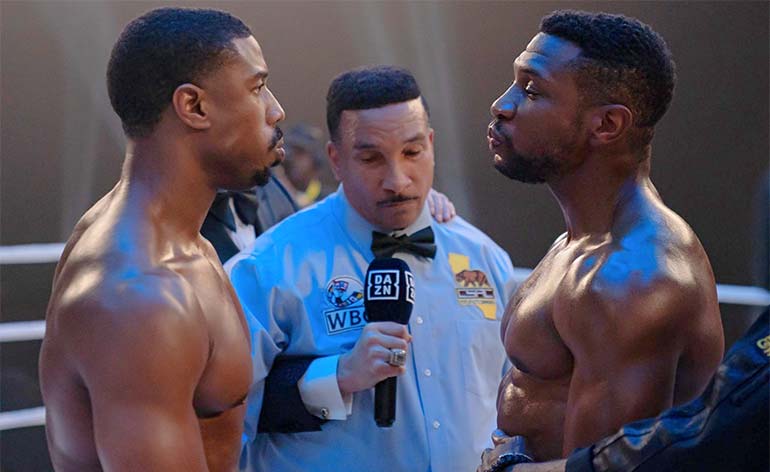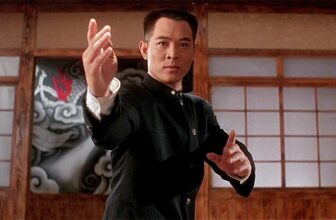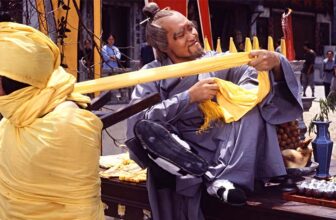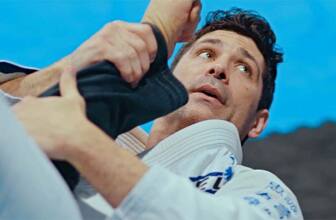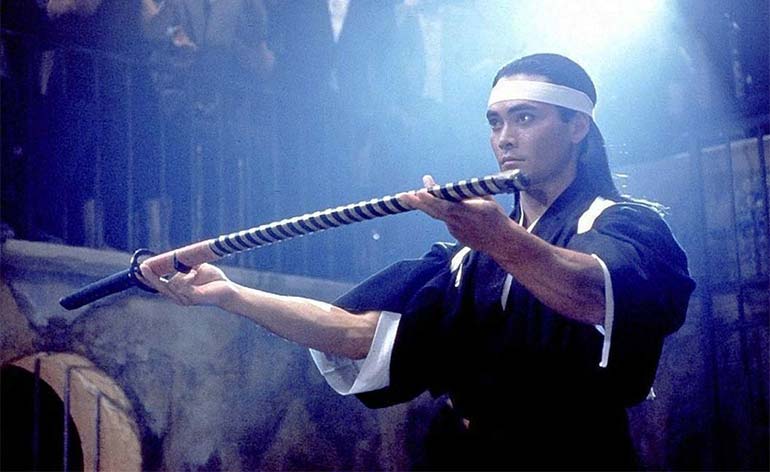
Take the premise of ‘Bloodsport’ then give everybody a bladed weapon and have them fight to the death!
That’s what you get from this DTV hit from 1992 starring the other ‘American Ninja’ David Bradley.
After the lukewarm reception in the second and third ‘American Ninja’ sequels – ‘Bloodhunt’ and ‘Annihilation’ with Michael Dudikoff – Bradley was given another shot at action stardom.
With Cannon films bringing in their go-to action director Sam Firstenberg (‘Revenge of the Ninja’, ‘Avenging Force’, ‘American Ninja’) the result was an arena film with plenty of gore and lots of jaw-dropping weapon displays, with Bradley given the chance to shine.
It also gave the world a rising action superstar in Mark Dacascos. So after 30 years from its first release how kind have the years been to this slice and dice action classic? Let’s take a look!
Trailer
Cast
David Bradley stars as ‘Drew Collins’, an American reporter trained in the ways of the Samurai who travels to Turkey to find his colleague’s killer, believing it may have been his brother ‘Kenjiro’ played by Mark Dacascos.
Accompanying Drew on his assignment is photo journalist ‘Janet’ played by Valarie Trapp, who soon gets caught up in Drew’s deadly sibling rivalry.
The late John Fujioka reprises essentially the same role from American Ninja, this time as Samurai sensei Tetsuyo Sanga who teaches the young Drew all about the way of Bushido.
In the arena fighting for the life-changing cash prize and to stay alive are: Rex Ryon as American knife-wielder ‘Ed Harrison’,
Douglas ‘Rocky’ Donald who not only serves as the film’s stunt and fight coordinator, but also appears as the Conan-esque axe warrior. Hong Kong action choreographer Dion Lam plays Wushu fighter Hsing Yi Lee
Australian-born actor, director, and stunt coordinator Antony Szeto plays Phan-Xu, another
Wushu expert whose hair extension proves to be a deadly weapon!
Australian Kyokushin Karate champion turned-stuntman Ron Vreeken, plays McKinney, a musclebound fighter packing a shiny guandao.
Plot
After a plane crash in the Japanese mountains, the only survivor, Andrew ‘Drew’ Collins as a baby is adopted by master samurai Tatsuya Sanga.
Drew, along with Sanga’s son, Kenjiro, is trained in Bushido. As Drew excels in his training surpassing his stepbrother, Kenjiro’s jealousy pushes him to join the Yakuza. He leaves his father’s home, swearing to one day take revenge on his brother.
Ten years later, Drew is back in the USA working as a journalist. He and photojournalist Samantha track down an opium-smuggling operation in Turkey.
Soon, the drug dealers kidnap the reporters and force Drew to fight in a deadly weapons-based martial arts tournament ruled by illegal gamblers. There he faces the tournament’s greatest champion, his brother Kenjiro.
Review
There is something disconcerting about ‘American Samurai’, a film produced during the most turbulent period of Cannon Films and unsure of the kind of film it wants to be.
It starts off as an ‘American Ninja’ clone, before moving onto a film noir complete with Drew’s narration which is then dropped when the Bloodsport-esque plot kicks in.
Thankfully veteran Cannon action film director, Sam Firstenberg guides us through this rocky terrain into more comfortable territory. Where the film finds itself, is in the caged arena and an assortment of colourful bladed warriors fighting to the death with action choreography courtesy of Rocky McDonald.
Samurai in Training
Predictably the film starts off with a young Drew learning the Samurai ways, and here is the film’s weak point.
The sword training is adequate and David Bradley is skilled with the Katana. For a training scene it lacks the variety of methods and drills with not enough time given to see the young Drew’s progress.
What makes up for this is the focus on the film’s central conflict between Drew and Kenjiro, with Dacascos literally seething as the increasingly-bitter sibling. It’s not hard to see the emerging talent of the action legend we know today.
Bradley as the now adult Drew, offers a snippet of his martial talent fighting some home invaders sent by Kenjiro, and later in a bar fight before the main event.
In both those scenes he seems more at ease with the style and techniques which are not only more varied but look like they’re actually doing some serious damage.
Much of this does feel a little rushed and one can’t help but get caught up in the seeming impatience of the movie to get to where we know the real action happens.
Enter the Bladed Arena
The film’s strengths lie here in the arena and onwards. The setting and film’s lighting create a tense, uncomfortable atmosphere; you can almost feel yourself in the aisles caught up in the stench of adrenaline and death permeating the venue.
The steel-on-steel action is brutal to say the least with slicing, dicing, severing of limbs, and gory decapitations aplenty so it shouldn’t come as a surprise to learn the film endured a few cuts of its own.
Some scenes are clearly played for laughs and serve as light entertainment, even predictable ‘cannon’ fodder (no prizes for guessing who); the ‘Conan’ warrior and Lars Olsen’s Viking warrior are nothing more akin to the clowns in bull fights and rodeos killing time until the real events kick off.
Whilst the film centres on Drew and his noble quest, plenty of attention is given to the other fighters to show off their skill before their demise.
The fight between Wushu warriors Hisang Yi Lee and Phan-Xu is presented as a much-anticipated showdown outside of the main story because let’s face it who doesn’t enjoy a bit of good old fashioned kung-fu fighting!
Hong Kong veterans Dion Lam and Antony Szeto show off many of the best traits of Wushu from the complex sword and Guan Dao weapons techniques to some veritably crowd-pleasing agile acrobatics.
Giving Australian martial artist Ron Vreeken a chinese weapon, though, was an interesting choice by the filmmakers given that Vreeken holds high rankings in Japanese systems.
Yet he sells his skills well on screen and gets to enjoy being a bit of a bloodthirsty character. The film however belongs mostly to Bradley and Dacascos, and serves to build up the inevitable conclusion of a charged sibling samurai rivalry.
The Brothers Face Off
As a stoic, serious-minded samurai, David Bradley is effective enough and gets to balance some solid drama with a comic one liner or two; “You got a headache?” he asks Olsen after smacking his head with the dull end of his katana.
Yet stoic and noble is what you get more of especially in the fight action as the only warrior in the ring who doesn’t want to kill his opponent.
For this brand of fighting without killing, samurai style, Drew’s opponents feel the impact of the katana’s handle and scabbard along with its flat side, and the sting of non-lethal cuts.
This approach breaks up the brutality of the blood and gore, and allows for Bradley to execute some resourceful-looking techniques. By contrast, Dacascos isn’t given as much range as an actor as a martial artist.
Stuck with a character that is permanently enraged and immersed in a single emotion it’s hard to add other facets to the one dimensional Kenjiro. Yet his charisma fills the screen and so intimidating is his presence, that Kenjiro indeed proves to be a real threat to our American Samurai.
Coupled with his decisive sword skills, Dacascos brings to life a very formidable and purposeful villain.
It’s a shame that in his debut role we don’t see that much of his agile martial arts repertoire, confined mainly to basic draws and slices of the katana.
However his poise and movements are swift and graceful adding to Kenjiro’s mystique. The action picks up nearer the finale when Kenjiro faces Phan Xu with more dynamism and dexterity. However waiting in the wings is that inevitable brotherly showdown.
The anticipated final fight is a mixed bag of vintage swordplay and family drama; whilst the more crowd-pleasing acrobatic fight action is absent, what we are given is a display of the poise and simplicity of classic Kenjitsu wrapped up in some movie-style Samurai rituals.
Bradley and Dacascos’ fighting styles might be far-removed from those of the Samurai, but with Rocky McDonald’s meticulous choreography and director Sam Firstenberg’s penchant for directing riveting sword battles, they both shine.
The finale, which could have done with an extra couple of minutes to showcase some more sword action intricacy, even with its predictable finish, proves to be the icing on this blood-spattered cake.
Summary
‘American Samurai’ was better suited to be David Bradley’s debut feature than ‘American Ninja III’ as it was primarily a stand alone story, and not part of an existing franchise.
The script and the fight choreography played to Bradley’s strengths better and gave him more opportunities to shine. It has a shaky start but once the film ditches its attempt to create a martial arts noir with an out-of-place vocal narrative and tones of a detective story before moving to the arena, the action and the story ramp up.
The film might borrow from ‘Bloodsport’ yet more resembles ‘Shootfighter’ with a string of colourful characters (some sporting left of field outfits) and a mix of inventive and innovative weaponry.
These lend to the film’s more entertaining quality balancing out the intensity of the film’s more serious plot involving a fatal sibling rivalry, and themes of honour and obligation.
The fight action however is the film’s core strong point and Rocky McDonald ensures all the steel-on-steel combat is exciting, varied, and packed full of danger.
Thirty years on ‘American Samurai’ remains a solid, entertaining action film featuring some expertly-staged weapons combat, and in its star David Bradley, a talented performer finally showing his stuff, along with fellow rising talent Mark Dacascos, and it doesn’t disappoint.
Favorite Quotes
- “Nice hat!” – Drew (sarcastic remark to his Viking opponent.)
- “Nah mate! If I were to use my dick it’d be an unfair advantage” – McKinney
- “You have withstood the thunder of the past and the fire of the present. Leave with the wind of the future and let the eye of the mind guide your steps in whatever may come.” – Tatsuya Sanga
Trivia
-
- David Bradley holds Dan rankings in Shotokan Karate and Taekwondo, as well as having trained in Kung Fu and Aikido.
- Hong Kong action fans should recognise the leather clad spear-wielding
- Haing Yi. He is none other than Dion Lam, a veteran of the Hong Kong film scene. Lam’s CV includes major titles including ‘Infernal Affairs’, ‘Black Mask’ with Jet Li, and ‘Heroic Trio’. He has also performed stunt duties on ‘Exit Wounds’ with Steven Seagal, and for Sam Raimi on the 2004 web slinging blockbuster ‘Spiderman II’.
- The film’s stunt and fight coordinator was Australian stuntman Douglas ‘Rocky’ McDonald, who also played the broadsword wielder dressed as Conan.
- By the time he was hired for ‘American Samurai’ Rocky was already a 10-year stunt veteran. He worked with fellow Aussie martial artist Edward Stazak on the Jason Blade films ‘Day of the Panther’ and ‘Strike of the Panther’, and was a stuntman on 1989’s ‘The Punisher’ starring Dolph Lundgren.
- Rocky’s 40-year career has seen him set up stunts for big Hollywood films including ‘Power Rangers; The Movie’, ‘Mission Impossible II’, and ‘Mad Max: Fury Road’.
- As a martial artist Rocky holds black belts in Zendo Kai Freestyle Karate, Jiu Jitsu, kickboxing, Kendo, and Kenjitsu (Japanese sword art).
- It’s ironic that the muscular, blonde-haired fighter McKinney wields a Chinese glaive or Guan Dao. Actor and stuntman Ron Vreeken specializes in Japanese fighting arts that include Nihon Jujutsu, Kyokushin Karate, Judo, and Dutch Kickboxing. He was also inducted into the Blitz Hall of Fame and named Martial Artist of the Year in 1997.
- Although never having been the star of his own work, Hawaiian actor John Fujioka has featured in many major film and television roles. Notable works include ‘The Octagon’ with Chuck Norris, and ‘Mortal Kombat’ (1995).
Film Rating: 7/10
What do you remember best about ‘American Samurai’? How does the fight action look some 31 years after it was originally released? Let us know in the comments below; Like, share and join in the conversation on Facebook and follow us on Twitter & Instagram!
TAKE A TRIP DOWN ACTION MEMORY LANE in the KINGDOM of FU with our exclusive interviews, get your stealth on in KFK wear, and subscribe for more 90’s vengeance FU on YouTube!
















